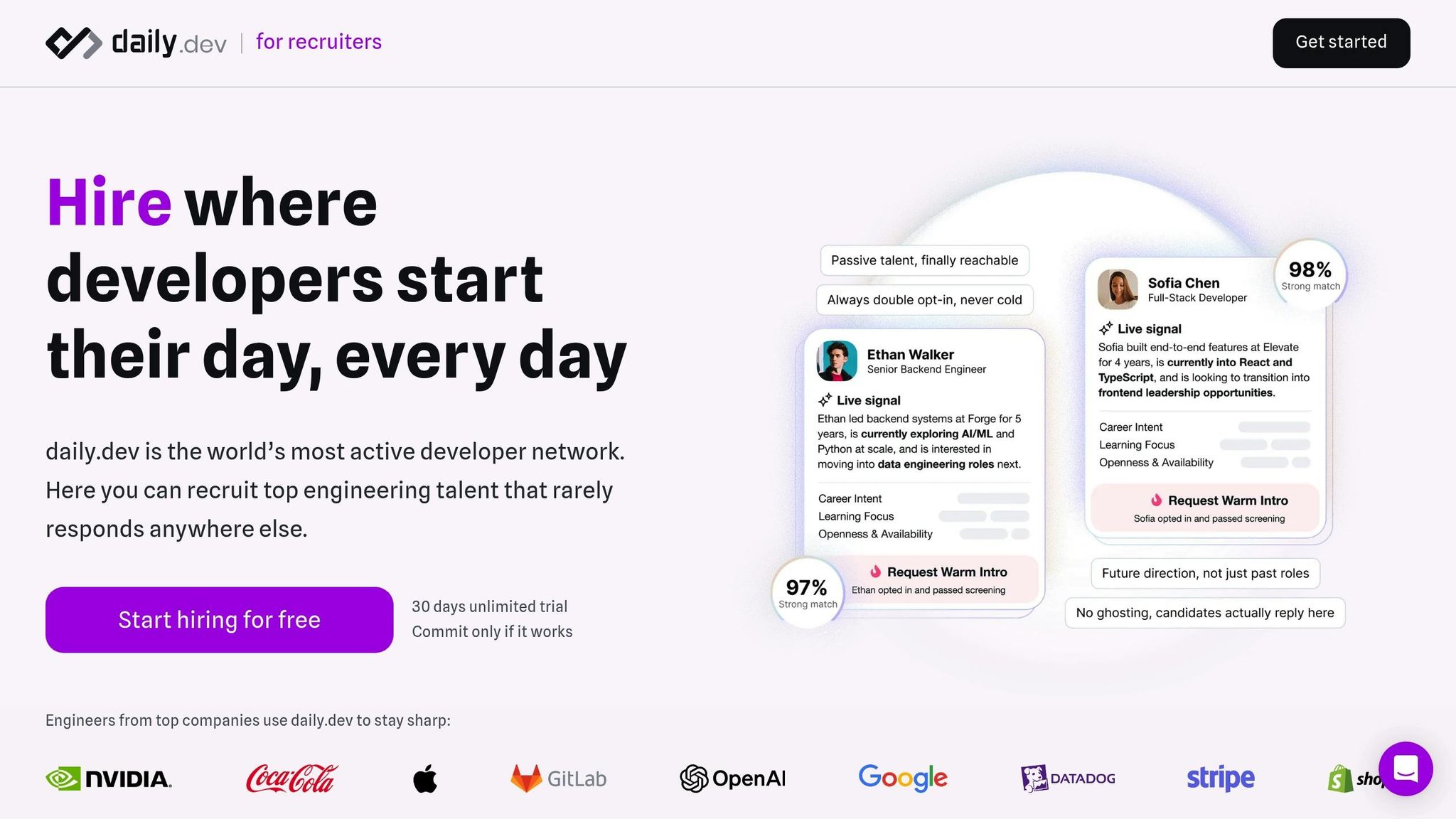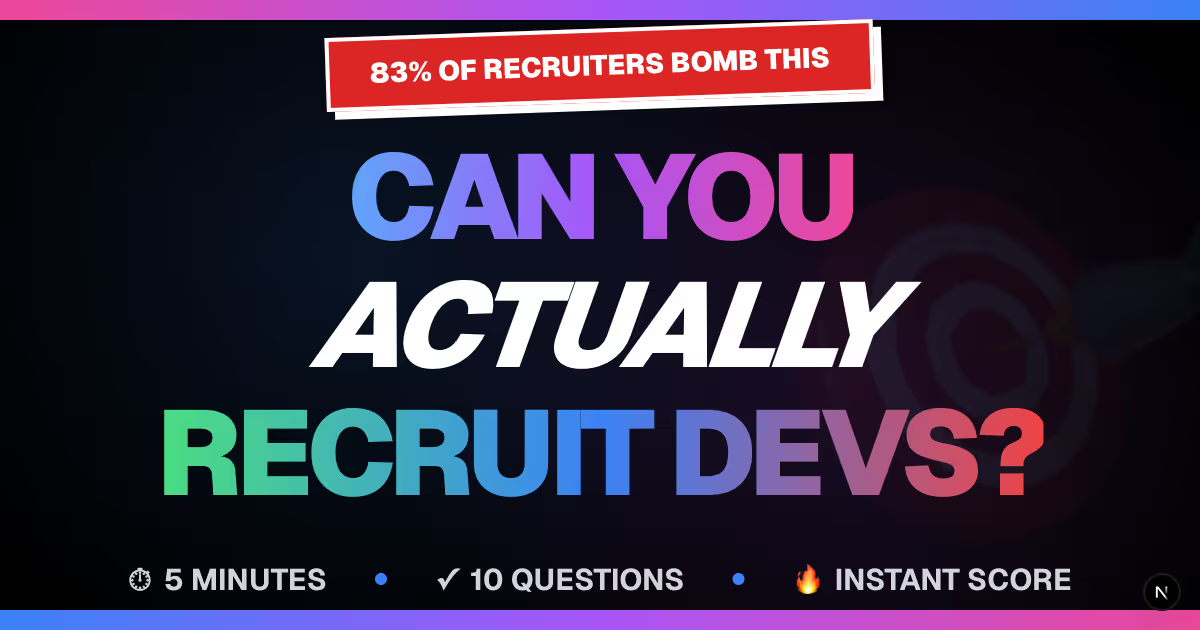


Explore the pros and cons of cold emails vs. warm introductions in developer recruitment to optimize your hiring strategy.
When recruiting developers, the choice between cold emails and warm introductions can significantly impact your results. Here's a quick breakdown:
- Cold Emails: Efficient for broad outreach, cost-effective, and scalable. However, they often suffer from low response rates (1–5%), spam perception, and impersonal communication.
- Warm Introductions: Build trust through existing connections, leading to higher response rates (21–34%) and meaningful conversations. However, they are slower, harder to scale, and depend on the strength of your network.
Quick Comparison
| Metric | Cold Emails | Warm Introductions |
|---|---|---|
| Response Rate | Low (1–5%) | High (21–34%) |
| Conversion Rate | Lower | Higher |
| Time-to-Hire | Longer due to follow-ups | Shorter, trust speeds up |
| Scalability | High | Limited by network size |
| Cost Efficiency | Low per email | Higher engagement saves time |
| Engagement Quality | Often surface-level | Deeper, based on trust |
Key Insight: For broad hiring needs, cold emails can help you cast a wide net. For senior or niche roles, warm introductions are more effective. Platforms like daily.dev Recruiter combine the best of both by connecting recruiters with pre-qualified developers in their active spaces, ensuring higher engagement and trust.
Bridging the gap between recruiters and engineers
Cold Emails: Benefits and Drawbacks
Cold emails are a go-to strategy for reaching developers. They’re fast, scalable, and cost-effective, but they often struggle with engagement and trust.
Benefits of Cold Emails
One of the biggest perks of cold emails is scalability. You can reach thousands of developers without significantly increasing costs. This makes cold emails especially appealing for startups or companies looking to grow quickly. Unlike phone calls or face-to-face meetings, sending emails doesn’t require much extra time or resources as your audience grows.
Another major advantage is their speed and automation. With automation tools, you can send hundreds - or even thousands - of emails in just a few hours. This efficiency can be a game-changer when you need to launch a campaign quickly.
Cold emails also offer asynchronous communication, which is a great fit for busy developers. They can read and respond when it’s convenient for them, even if they’re in a different time zone or juggling tight project deadlines.
They’re also budget-friendly. Reaching a large audience via email is far cheaper than making calls or arranging in-person meetings, which makes cold emails a cost-efficient way to explore new opportunities.
Another plus is the ability to include supporting materials. Whether it’s job descriptions, company culture videos, or portfolio links, you can attach resources that help developers better understand your message.
"Interestingly, 80% of buyers prefer email communication with sales representatives", emphasizing email's role as a highly scalable tool for lead generation.
While these strengths make cold emails an attractive option, they’re not without their challenges.
Problems with Cold Emails
The biggest downside? Low response and conversion rates. Generic campaigns typically see response rates of 8–9%, but unpersonalized outreach often drops to a mere 1–3%. For comparison, warm leads convert at a much higher rate of around 14.6%.
Another issue is that cold emails are often labeled as spam. Many recipients view unsolicited emails negatively, which can hurt your sender reputation. Worse, spam filters may block your emails entirely, reducing their chances of being seen.
Impersonal messages make things worse. Templates that don’t reference a developer’s skills, recent projects, or interests come across as lazy. This lack of effort can make your outreach seem untrustworthy, turning developers off.
Deliverability problems are another hurdle. Spam filters have become more advanced, and poor email practices can damage your sending reputation. This can lead to lower deliverability rates - or even getting blacklisted.
Finally, there’s the risk of harming your brand’s reputation. If your emails are seen as intrusive or spammy, word can spread quickly in developer communities. This can make it harder to engage top talent in the future.
Cold email open rates usually range between 15–24%, which pales in comparison to the 21–34% seen with warm emails. The next section will dive into how warm introductions can help address these challenges.
Warm Introductions: Benefits and Drawbacks
Warm introductions offer a more personal, relationship-focused approach to reaching developers, standing in stark contrast to the often impersonal nature of cold emails. By tapping into existing connections, you can create a more engaging and credible entry point for conversations.
Benefits of Warm Introductions
Higher response and conversion rates are a standout advantage. When a mutual connection vouches for you, trust is built right away. This pre-established credibility makes developers more likely to respond positively, reducing skepticism and increasing engagement compared to cold outreach.
Deeper, more meaningful conversations often follow. With trust already in place, you can skip the surface-level pleasantries and dive into discussions that resonate with candidates, like their career aspirations, technical interests, and how they might fit into your company’s culture.
Less chance of being perceived as spam. Warm introductions feel more personal and respectful, striking the right tone. This approach helps create a positive impression, showing candidates that their time and preferences are valued.
Building long-term relationships becomes easier. Even if a candidate isn’t the right fit for a current role, the respectful and thoughtful nature of a warm introduction lays the groundwork for future opportunities. This is invaluable for creating a strong talent pipeline.
That said, while warm introductions shine in many ways, they’re not without their limitations.
Drawbacks of Warm Introductions
The main challenge with warm introductions is scalability. Your outreach is limited by the size and scope of your network. If you’re hiring for multiple roles or need candidates with niche skills, relying solely on existing connections can quickly become a bottleneck.
Time and effort constraints are another hurdle. Building and maintaining the relationships needed for effective warm introductions takes significant energy. Plus, you’re often dependent on your contacts’ availability and willingness to make connections, which can slow the process.
Geographic and skill gaps in your network can also pose issues. If your connections are clustered in specific regions or industries, it may be tough to find candidates with the exact skills or location you’re targeting.
Timing can be unpredictable, too. Unlike cold emails, which can be sent on your schedule, warm introductions rely on others’ timelines. Coordinating with busy contacts can delay your hiring efforts, especially when time-sensitive roles need to be filled.
Lastly, there’s a risk of overusing your network. Repeatedly asking for introductions can strain relationships, particularly if the hiring outcomes don’t meet expectations. This can make people hesitant to help in the future.
In competitive hiring markets, the slower pace of warm introductions can be a disadvantage. Building trust, requesting introductions, and coordinating schedules takes time - time that you might not have when trying to secure top talent quickly.
sbb-itb-d1e6221
Cold Emails vs Warm Introductions: Side-by-Side Comparison
When it comes to reaching out to developers, the method you choose can significantly impact your hiring results. Let’s break down how cold emails and warm introductions stack up across key recruitment metrics.
Performance Metrics Comparison
| Metric | Cold Emails | Warm Introductions |
|---|---|---|
| Response Rate | Lower; broad outreach often leads to fewer meaningful replies | Higher; trust from mutual connections boosts engagement |
| Conversion Rate | Generally lower due to less personalization | Higher, thanks to pre-existing interest |
| Time-to-Hire | Longer, as it involves follow-ups and building rapport | Shorter, since candidates are already primed to engage |
| Cost Efficiency | Hidden costs can arise from managing low-quality leads and follow-ups | More efficient due to better initial engagement |
| Engagement Quality | Often transactional and surface-level | Deeper, with more meaningful and contextual conversations |
| Trust Factor | Minimal trust, often seen as intrusive | Built on established relationships, fostering credibility |
| Scalability | Easily scalable for broad outreach | Limited by the size of your existing network |
| Spam Perception | Frequently viewed as spam by recipients | Rarely seen as intrusive or unsolicited |
This table highlights the clear distinctions between the two approaches.
What the Data Shows
These metrics reveal practical implications for your hiring strategy. Cold emails allow you to cast a wide net, reaching developers across diverse skill sets and locations. However, the trade-off is lower engagement quality, and in some cases, this approach can even harm your employer brand if perceived as impersonal or spammy.
On the other hand, warm introductions thrive on trust and existing relationships, making the process smoother and more efficient. Candidates reached through trusted channels are typically more responsive, require less follow-up, and offer stronger engagement. This targeted approach also reduces time wasted on unqualified leads, making it a cost-effective choice.
That said, cold emails still have their place - especially when you're looking for niche technical skills or expanding into regions where your network may be thin. Many recruiters find success by combining both strategies: using warm introductions to fill high-priority roles and supplementing with cold outreach for broader coverage.
Ultimately, the most effective approach leverages trust where it exists while maintaining the ability to scale your reach strategically.
How daily.dev Recruiter Improves Warm Introductions

Traditional warm introductions often rely on the strength of your existing network. But daily.dev Recruiter flips the script by creating a developer-centered platform that fosters authentic connections. Instead of depending on who you already know, it connects you with developers where they naturally spend time learning and growing in their field.
Double Opt-In Introductions
With daily.dev Recruiter, every connection is built on a double opt-in process. This means both the employer and the developer must show genuine interest before any interaction begins. By doing this, the platform ensures developers aren’t caught off guard by unsolicited messages.
Before introductions are made, both parties receive detailed context. Developers get insights into the role, company culture, and technical challenges, while employers learn about the developer’s skills, interests, and career aspirations. This approach ensures that conversations start with meaningful substance rather than generic small talk.
Because developers actively choose to engage, recruiters only interact with candidates who are genuinely interested in exploring opportunities. This streamlined approach provides access to a carefully curated pool of qualified talent.
Connecting with Pre-Qualified Developers
daily.dev Recruiter goes beyond traditional outreach by connecting employers with passive, pre-qualified developers - professionals who are actively enhancing their skills but may not be actively job hunting. These developers are already immersed in daily.dev, reading technical articles, learning about new technologies, and engaging in discussions with peers.
The platform provides real-time insights into developers’ interests. For instance, if a developer is reading articles about React or participating in discussions on cloud architecture, it highlights their current expertise and interests - something traditional recruiting methods often miss.
This strategy solves one of the toughest challenges in tech recruitment: reaching skilled developers who aren’t actively searching for jobs. By connecting with these professionals in their natural professional environment, the platform creates opportunities that cold outreach simply can’t replicate.
Boosting Efficiency and Trust in Hiring
daily.dev Recruiter doesn’t just streamline the hiring process - it also builds trust. Unlike mass outreach methods, this platform focuses on creating targeted, trustworthy matches.
Consider this: cold emails typically see reply rates of just 2-10%, while traditional warm introductions can improve that to 10-34%. In contrast, daily.dev Recruiter’s double opt-in system significantly increases engagement because both parties are already committed to the conversation before it begins.
The trust built into the platform reduces common recruitment pain points. Developers don’t have to question the legitimacy of opportunities, as the community-driven environment naturally filters out low-quality options. Likewise, employers avoid wasting time on unqualified candidates because matches are based on technical skills, experience, and career goals.
This method also shortens the hiring timeline. While warm introductions typically close deals in about three months, cutting time-to-revenue in half, daily.dev Recruiter’s structured process retains these speed advantages while making them accessible to companies without established developer networks.
Choosing the Right Outreach Method
When it comes to developer outreach, research makes one thing clear: warm introductions outperform cold emails by a wide margin. While cold emails typically see response rates of just 1–5%, warm introductions boast open rates between 21% and 34%. But finding the right approach often depends on your hiring goals and the type of talent you're targeting.
Cold emails can still play a role, especially in large-scale hiring or when you're reaching beyond your immediate network. They’re a practical way to connect with a high volume of developers quickly. However, their effectiveness hinges on how well you tailor your message and understand their limitations. This approach becomes less effective when you're focusing on highly specialized or senior roles.
For those specialized or senior positions, warm introductions are the clear winner. Developers in senior roles are more selective and tend to value personal connections. For example, one tech startup saw a dramatic improvement when they switched from cold emails (with a 2% response rate) to warm, double opt-in introductions. This change led to 10× more meaningful conversations and significantly sped up their hiring process.
daily.dev Recruiter bridges the gap between scalability and personalization by connecting you directly with pre-qualified developers in their active environments. This approach maintains the trust and engagement benefits of warm introductions by ensuring you're reaching candidates in a space where they’re already engaged professionally.
Trust plays a critical role in developer outreach. Developers are increasingly tuning out generic, unsolicited messages. With daily.dev Recruiter’s double opt-in system, both parties agree to engage, ensuring you're only connecting with candidates who are genuinely interested in the opportunity. This trust-driven approach is at the heart of effective outreach.
When choosing your outreach method, think about your hiring priorities. If you need to fill multiple roles quickly, a combination of personalized cold emails and warm introductions might work best. However, if quality and fit are your main concerns - especially for senior or niche roles - high-context introductions will save time and attract stronger candidates.
The future of developer recruitment is shifting away from volume-based tactics. Instead of competing in crowded inboxes, focus on connecting with talent where they’re already active and engaged. Building trust and intent is what truly sets effective outreach apart.
FAQs
What’s the best way to balance cold emails and warm introductions in developer recruitment?
To find the right balance between cold emails and warm introductions in developer recruitment, focus on crafting thoughtful, personalized outreach that acknowledges the recipient's time and interests. Warm introductions - leveraging mutual connections or shared networks - can establish trust and credibility, increasing the chances developers will respond positively.
That said, cold emails can still work when done right. The key is to make them specific, brief, and relevant. Customize each message to align with the developer’s experience and interests, steering clear of impersonal templates. By blending the trust-building power of warm introductions with the wider reach of cold emails, you can create a recruitment strategy that’s both effective and respectful.
Tools like daily.dev Recruiter simplify this process by enabling warm, double opt-in introductions with developers who are already active and pre-qualified. This approach ensures your outreach feels purposeful, making developers more receptive to opportunities while saving time and building stronger connections.
What are the best ways to increase response rates when sending cold emails to developers?
To get better responses from developers through cold emails, personalization is everything. Take the time to reference their specific interests, recent work, or notable accomplishments. This extra effort can make your email feel genuine and help it stand out in a crowded inbox.
Keep your message short and to the point. Developers appreciate clarity and efficiency, so skip the long intros and irrelevant details. Use a clear subject line and craft a brief, engaging message that gets straight to the point - this can make a big difference in whether your email gets opened and answered.
Lastly, prioritize building trust. Be upfront about why you're reaching out and make sure your email offers something of value to the recipient. A well-thought-out message that respects their time is far more likely to get a positive response.
How does daily.dev Recruiter's double opt-in approach make warm introductions more effective?
daily.dev Recruiter uses a double opt-in process to make sure that connections between developers and recruiters are truly mutual. Developers are only contacted after they’ve given clear consent, which means no unsolicited messages or irrelevant pitches.
This system builds trust, resulting in better response rates, more productive conversations, and stronger matches. By prioritizing genuine interest on both sides, daily.dev Recruiter turns outreach into a smooth and valuable experience for everyone involved.
Related Blog Posts








